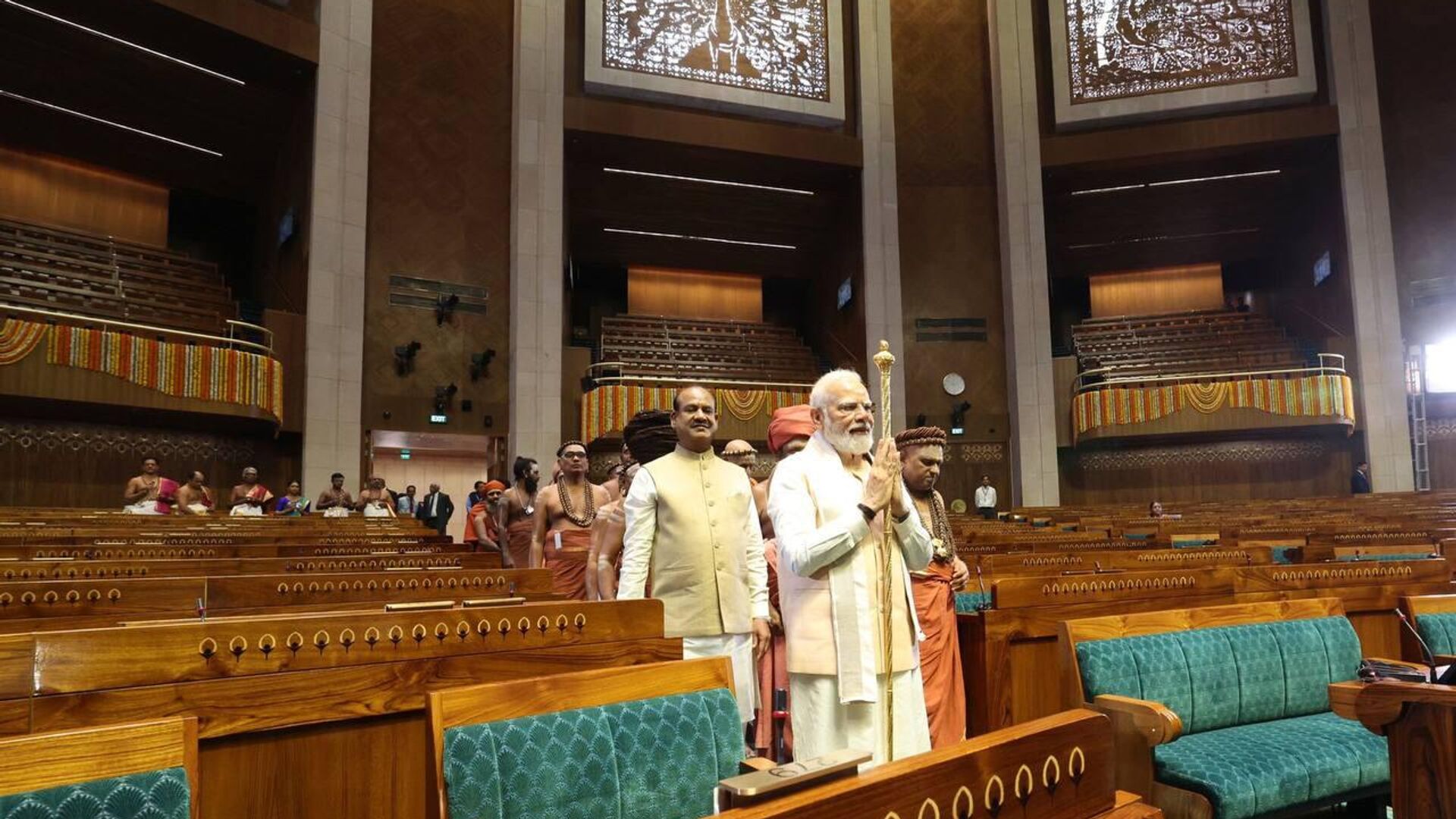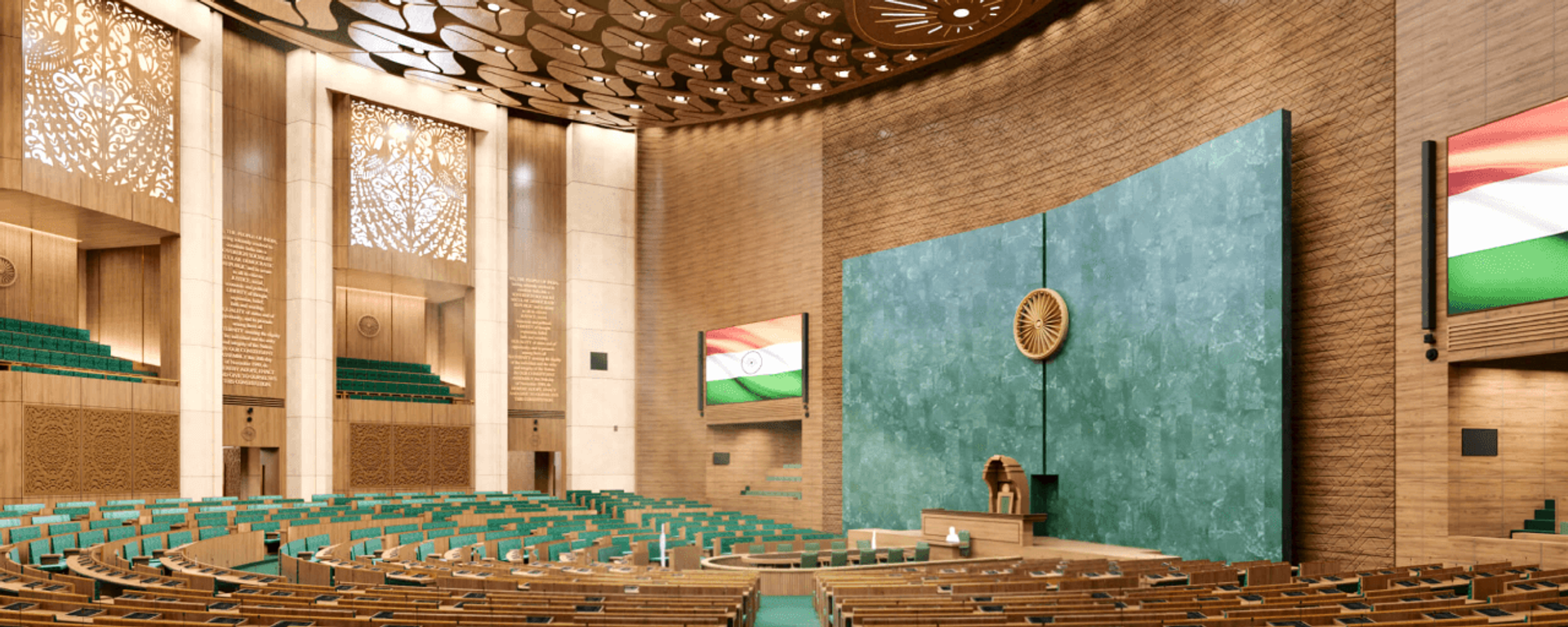PM Modi Opens New Parliament Building Amid Boycott by Opposition Parties
13:58 28.05.2023 (Updated: 15:45 28.05.2023)

© Photo : Twitter/ @narendramodi
Subscribe
India's old parliament building, opened in 1927, was built by the country's former colonial rulers, the British.
Indian Prime Minister Narendra Modi has unveiled the new parliament building in New Delhi amid a wave of criticism and a boycott of the ceremony by several opposition parties, including the main rival, Congress.
Twenty opposition parties have demanded that President Droupadi Murmu inaugurate the new building instead of Modi. But when the government announced that the PM would be doing the honors, they chose to skip the ceremony, branding it as a "violation of the spirit of the constitution".
India's PM marked the inauguration of the new triangle-shaped building in the heart of central Delhi by unveiling a plaque.
Modi arrived at the new parliament complex at 7:30 am. Subsequently, the Indian leader and Lok Sabha (lower house of parliament) Speaker Om Birla conducted a prayer service. Once the prayers ended, the PM installed the historic "Sengol" sceptre on the Lok Sabha's premises.
Twenty opposition parties have demanded that President Droupadi Murmu inaugurate the new building instead of Modi. But when the government announced that the PM would be doing the honors, they chose to skip the ceremony, branding it as a "violation of the spirit of the constitution".
India's PM marked the inauguration of the new triangle-shaped building in the heart of central Delhi by unveiling a plaque.
Modi arrived at the new parliament complex at 7:30 am. Subsequently, the Indian leader and Lok Sabha (lower house of parliament) Speaker Om Birla conducted a prayer service. Once the prayers ended, the PM installed the historic "Sengol" sceptre on the Lok Sabha's premises.
After installing the "Sengol" near the Lok Sabha Speaker's chair, Modi went on to congratulate a group of workers who were involved in the construction of the complex.
After that, representatives of all of India's prominent religions, namely, Hinduism, Buddhism, Sikhism, Jainism, Islam, and Christianity, held a joint prayer.
In the new parliament building, the Lok Sabha chamber can seat 888 legislators, while the Rajya Sabha (upper house of parliament) can seat as many as 384 members.
This is a significant rise from the 552 and 250 seating capacity that the old parliament could accommodate in the Lok Sabha and Rajya respectively, in full.
Moreover, the new building's Lok Sabha chamber can house 1,280 lawmakers if and when the parliament is hosting a joint meeting of both houses.
The total built-up area of the four-story building is 64,500 square meters. Besides having different entrances for visitors, MPs, and VIPs, the complex has three main gates - Shakti Dwar (Power Gate), Gyan Dwar (Knowledge Gate), and Karma Dwara (Action Gate).
Constructed by Tata Projects Ltd., the new parliament building also includes a lounge for lawmakers, a library, dining areas for MPs, and a constitution hall that would showcase the history of India's democracy.
Moreover, it provides ample parking space for vehicles belonging to both visitors and VIPs.
After that, representatives of all of India's prominent religions, namely, Hinduism, Buddhism, Sikhism, Jainism, Islam, and Christianity, held a joint prayer.
In the new parliament building, the Lok Sabha chamber can seat 888 legislators, while the Rajya Sabha (upper house of parliament) can seat as many as 384 members.
This is a significant rise from the 552 and 250 seating capacity that the old parliament could accommodate in the Lok Sabha and Rajya respectively, in full.
Moreover, the new building's Lok Sabha chamber can house 1,280 lawmakers if and when the parliament is hosting a joint meeting of both houses.
The total built-up area of the four-story building is 64,500 square meters. Besides having different entrances for visitors, MPs, and VIPs, the complex has three main gates - Shakti Dwar (Power Gate), Gyan Dwar (Knowledge Gate), and Karma Dwara (Action Gate).
Constructed by Tata Projects Ltd., the new parliament building also includes a lounge for lawmakers, a library, dining areas for MPs, and a constitution hall that would showcase the history of India's democracy.
Moreover, it provides ample parking space for vehicles belonging to both visitors and VIPs.


